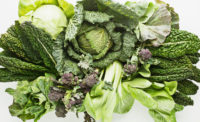FDA’s Leafy Greens Action Plan: FY2021 Sampling Results, Future Targeted Sampling

Credit: 5rca via Unsplash
The U.S. Food and Drug Administration (FDA) has announced that it will conduct targeted sampling of leafy greens as part of the Leafy Greens STEC Action Plan (LGAP). FDA will focus on leafy greens that are grown on farms and ranches during the autumn 2022 harvest season in the Salinas Valley region of California. FDA also released the results from a Fiscal Year 2021 (FY2021) sampling assignment, and is providing an update on other work under the action plan.
Targeted Sampling
During the autumn 2022 harvest season, FDA plans to collect approximately 240 lettuce samples at farms and ranches in the Salinas Valley. The chosen farms and ranches were identified by recent traceback investigations as being potentially associated with a foodborne illness outbreak in which lettuce or leafy greens were the likely or suspect food vehicle. FDA may also collect environmental samples such as water, soil, and animal waste, as appropriate, based on observations made at the time of sampling and a farm or ranch’s past inspection history. All samples will be tested for several species of Salmonella and Shiga-toxin producing Escherichia coli O157:H7 (STEC). Sampling will begin in mid-September 2022 and run through October 2022.
FY21 Assignment Summary Report
Between May and November of 2021, FDA conducted a different leafy greens sampling assignment. The agency is now releasing a summary of those results. As part of the FY2021 assignment, FDA collected lettuce from commercial coolers in the Salinas Valley growing area of California and tested samples for STEC and Salmonella spp. The report describes the agency’s detection of Salmonella enterica in one green leaf sample and STEC in two other samples. In all cases, potentially contaminated product was destroyed and follow-up inspections were conducted.
Leafy Greens STEC Action Plan Update
FDA believes that continued outbreaks and ongoing concerns about leafy green contamination emphasize the need for continued efforts related to prevention across the supply chain. Over the last two years, the agency has taken steps to enhance the safety of leafy greens through LGAP, which can be found on the updated LGAP webpage.
The web update expands on the work FDA has done, in collaboration with partners in the public and private sectors, to prioritize inspections and surveillance sampling, share data and research, conduct root cause investigations, and build relationships that have contributed to enhancing the collective understanding of the issues associated with leafy green contamination. FDA has highlighted several actions it has taken under LGAP, including:
- Published a proposed rule addressing pre-harvest agricultural water provisions of the Produce Safety Rule for covered produce other than sprouts. In addition, the agency has released resources and participated in engagement opportunities to help stakeholders better understand the proposed requirements.
- Continued to work closely with regulatory and industry partners in California to promote and offer technical assistance on the California Food Safety Roadmap and the California Agricultural Neighbors Interim Report on best practices to help enhance localized food safety efforts.
- Further refined a pre-harvest agricultural water treatment efficacy protocol, co-developed with the U.S. Environmental Protection Agency (EPA), to support pesticide registration of antimicrobial chemicals.
- Participated in several activities to advance testing methodologies, data-sharing, and research priorities as outlined in the action plan.
Looking Ahead
Over the next two months, multi-disciplinary food safety experts from across FDA will be visiting with leafy greens producers in California to learn more about leafy greens operations. Recent outbreaks have raised concerns about the sanitary design of harvest equipment and how field production and processing practices may be contributing to contamination events. The visits aim to enhance FDA’s understanding of the complexities of leafy greens production in order to further inform the agency’s work under the LGAP.
Looking for a reprint of this article?
From high-res PDFs to custom plaques, order your copy today!





